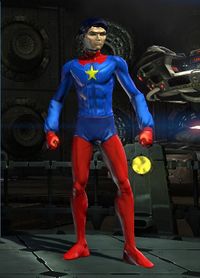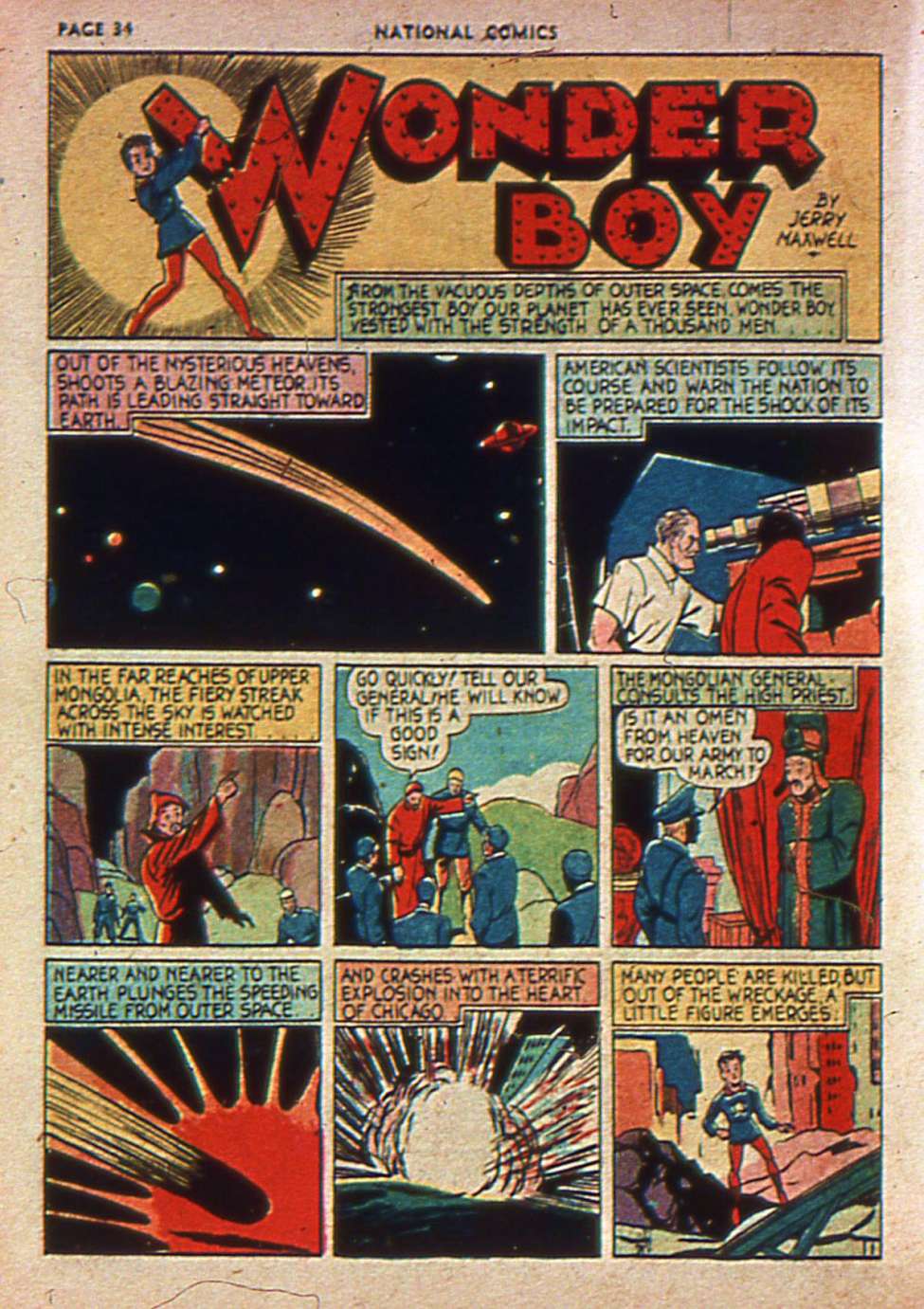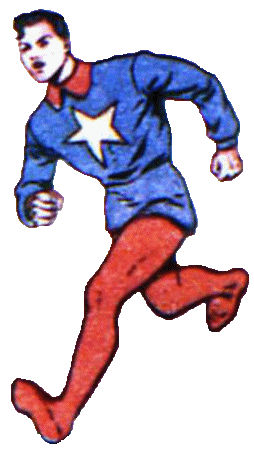Difference between revisions of "Wonder Boy"
Wonder Boy (Talk | contribs) |
Wonder Boy (Talk | contribs) |
||
| Line 21: | Line 21: | ||
==DC Comics biography== | ==DC Comics biography== | ||
| − | <div class="floatleft">[[File: | + | <div class="floatleft">[[File:WonderBoy1.jpg]]</div> |
Alter Ego: None<br /> | Alter Ego: None<br /> | ||
Other Alias: None<br /> | Other Alias: None<br /> | ||
Revision as of 00:31, 6 May 2012
| Wonder Boy | ||||||||||||||||
None
|
DC Universe Online biography
Wonder Boy of Viro is one of several other-dimensional heroes that were captured by Brainiac during the villain's numerous trips through time and the Multiverse. Brainiac had traveled the Multiverse in search of unique heroes and villains from many worlds including alternate Earths to use as an army. Wonder Boy was being used as a template for many of the new exobyte-enhanced humans until he was able to escape from a Brainiac ship with help from this Earth's Oracle and Superman. Upon escaping captivity, he discovered that he was on an alternate Earth and timeline from the one he had known. Wonder Woman offered Wonder Boy her aid and sponsored him as an honorary Justice League member seeking out his help in a series of adventures. Adjusting to his new life in this new time and this new Earth, Wonder Boy has joined a new team of heroes known as Young Unity which features several of the exobyte-enhanced and other trans-dimensional heroes that Brainiac had kidnapped.
Wonder Boy's current whereabouts are in Central City stopping the Reapers from destroying the timeline, but often aids his teammates and other heroes in Metropolis and Gotham City.
DC Comics biography
Alter Ego: None
Other Alias: None
Known Relatives: None
Homeworld: Viro
Height: 5' 10"
Weight: 190 lbs.
Eyes: Blue
Hair: Black
First Appearance: National Comics #1 (July 1940)
Powers: Super-strength, invulnerability and super-speed. In his later adventures, his strength seemed much more limited than when he debuted. Notably, Wonder Boy could not fly. His internal chemistry was susceptible in various ways such as poisoning and tear gas. More than once, when hit upon his head, he was momentarily knocked unconscious.
Weapons & Equipment: None
Origin/History: "The strength of a hundred full grown men in one little boy!” Wonder Boy hailed from the destroyed planet Viro, and fell to Earth in Chicago. He was picture of humanity, aside from his powers. The crash killed many people, but the boy survived. Nobody believed his origins and he found himself in an orphanage. Meanwhile, in Mongolia, a general took Wonder Boy’s craft as an omen to begin warring on Europe. Wonder Boy heard this news and swam all the way to Europe to help, where he successfully led the army to victory over the Mongolians.
NATIONAL COMICS #1–26 (July 1940–November 1942)
Wonder Boy debuts in "The Boy From the Meteor," from National Comics #1 (July 1940). Early in 1940, a meteor sped across the skies, alert astronomers tracking its landing area to Chicago, Illinois. Its appearance in the skies worried the shamen of Mongolia and they used it as an omen to attack their neighbors. As the meteor crashed, a young man crawled from the shell. Mistaken for an orphaned youth, he was sent to an orphanage. No one believed his story of his being the lone survivor of the planet Viro. Hearing from news broadcasts that Mongolia was being readied for war, the young boy took it upon himself to stop the upcoming conflict. Jumping over the walls of the orphanage, making his way to the coast and swam to Asia. Meeting up with western officials in Hong Kong, he made his way to Mongolia and ended the conflict. Returning to the US, the newly dubbed “Wonder Boy” roamed the nation, aiding the downtrodden, usually aiding the poor and homeless against ruthless landlords and criminals. National Comics #2 (August 1940): [The Pirates and the Buddha's Eyes] National Comics #3 (September 1940): [Rescuing the South American Expedition] National Comics #4 (October 1940): [Dinosaurs Out West] National Comics #5 (November 1940): [Cheatum the Crooked Landlord] National Comics #6 (December 1940): [The Johnny Doring Case] National Comics #7 (January 1941): [The Lost Mountain of Gold] National Comics #8 (February 1941): [The Bridge Busters] National Comics #9 (March 1941): [The Redrum Company] National Comics #10 (April 1941): [Underwater Treachery] National Comics #11 (May 1941): [The TAL Plane Crackups] National Comics #12 (June 1941): [The Carney Coal Mine Disaster] National Comics #13 (July 1941): [The Lost City] National Comics #14 (August 1941): [The Stratosphere Torpedo] National Comics #15 (September 1941): [The Mail Train Robbery] National Comics #16 (October 1941): [Pagi's Return To the Islands] National Comics #17 (November 1941): [The Bomb Release Saboteurs] National Comics #18 (December 1941): [The Central American Jungle Caper] National Comics #19 (January 1942): [Saving the Farm] National Comics #20 (February 1942): [The Kid Criminals] National Comics #21 (March 1942): [Looks are often deceiving...] National Comics #22 (April 1942): [Strolling through the city...] National Comics #23 (June 1942): [Idly fishing beside a spidery span...] National Comics #24 (August 1942): [Beneath the walls of a power plant...] National Comics #25 (October 1942): [Crime vicious and sneaking...] National Comics #26 (November 1942): [The long bloody hand of America's enemies...]
BOMBER COMICS #1-4 (Spring–Winter 1944)
Bomber Comics was a four-issue series printed by a very obscure publisher, Elliot. Jerry Iger revived a raft of former features including “Kid Dixon,” “Kid Patrol,” “Eagle Evans” and “Wonder Boy” from Quality; “Samson” from Fox; “Bobby” from Famous Funnies; and some new material, too. At Quality, the last of those features appeared in National Comics #32 (Sept. 1943).
SAMSON #12–13 (April–June 1955)
TERRIFIC COMICS #16 (March 1955)
WONDER BOY #17–18 (May–July 1955)
JERRY IGERS'S GOLDEN FEATURES #2 (1986)
Printed three Wonder Boy stories drawn by Matt Baker, but the volume did not identify the date of their creation. None of them are the same as what appeared in the Elliot or Ajax/Farrell comics. It is likely that these were unpublished stories, and the art is roughly the same as the published material, though it does not exhibit Baker’s usual finesse. Iger gushed: "...Another example is WONDER BOY. No secret identity for him! He's just the kind of kid every mother hopes her daughter will bring home to dinner—and he's a super hero to boot. Even after 30 years, WONDER BOY still has the same appeal of old fashioned American values, values that I sometimes miss today. May partner Lee Caplin and I are updating the story of WONDER BOY in preparation for a feature film. We're asking the question whether there ever could be a place for Wonder Boy in today's society. Our writer is Rob Ulin, the former Harvard Lampoon Editor."


